Cooling towers are explained along with it’s basic details, definition, parts, working principle, description of all components, applications, etc. Let’s explore the cooling tower!
What are Cooling Towers?
What is a Cooling Tower? Basics
The cooling tower is one of the important parts especially in power stations and large industries. In industries like sugarcane factories, the cooling tower helps a lot. We will get to know more about the cooling tower, it’s types and all the other information in this article.
- Basically, the cooling tower is a kind of heat exchanger that removes heat from the water, rejects waste heat to the atmosphere with the help of cooling of water stream at lower temperatures.
- Cooling towers are commonly seen in oil refineries, petrochemical, and chemical plants, thermal power stations and nuclear power stations, etc.
- Also, in the HVAC systems for cooling buildings.

The tower’s size varies depending upon the applications they are used and the amount of cooling required. Let’s see a brief about the Cooling tower’s history.
History of Cooling Towers
The cooling towers started from the 19th century with the development of condensers for using with the steam engines. The steam engines were getting so much popular in those days. As we already know the condensers can cool the water relatively reducing back pressure and reducing steam consumption. But the condensers require ample amount of cooling water without which they are impractical.
- The natural draft cooling tower in 1902 was Barnard fanless self-cooling tower.
- Later in the 20th century to meet the cooling needs the cooling ponds were used. They took the form of cooling towers. In the early days of cooling towers, they were placed on the rooftops either supplying air by fans or using the natural draft.
- The Dutch engineers Frederik van Iterson and Gerard Kuypers invents the cooling tower in 1918. Later in England, they were used at electrical power stations.
The classification of the cooling towers is vast and we will cover them with their detailed information. Before that, we should know the parts or components of the cooling towers and a brief detail about the components.
Terms in Cooling Towers
Dry-Bulb temperature
- Dry bulb temperature means the temperature of ambient air. If the thermometer is exposed to the atmosphere, then the reading is dry bulb temperature.
- It is represented by DBT.
Wet-Bulb temperature
- Wet-bulb temperature means the temperature of the air measured by a thermometer when a wet cloth is wrapped on the bulb.
- It is represented by WBT.
- If we observe the below diagram clearly, we can understand that wet bulb temperature is the lowest possible temperature that the cooling tower can give.
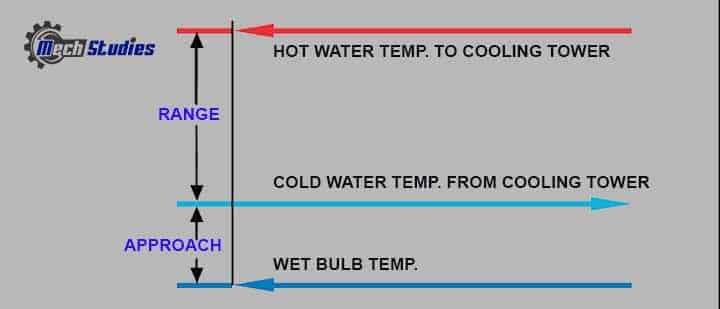
Approach
- The difference between the cooled-water temperature (cooling tower outlet) and the entering air wet-bulb temperature.
- It is measured in Deg. C.
- Cooling Approach = Cooling Water outlet Temp – Air WBT
- If the approach is near to WBT, efficiency will be high. More approach incurs less efficiency.
Cooling Range
- The difference between the hot water entering the tower and the cold water leaving the tower.
- It is also measured in Deg. C.
- Cooling Range = Cooling Water Inlet temp. – Cooling Water Outlet Temp.
- If the range is high, performance will be high and if the range is less, performance will be low.
Effectiveness (%)
- Effectiveness = Range / (Range +Approach) The difference between the hot water entering the tower and the cold water leaving the tower.
- Always high effectiveness is recommended as it increases performance.
Cycles of Concentration
- The cycle of concentration is the ratio of dissolved solids in circulating water to the dissolved solids in make-up water.
L/G Ratio
- L/G Ratio means Liquid/Gas ratio.
- It means the ratio of the mass flow rate of liquid & gas.
Dissolved Solids
- total solids dissolved in water.
Fouling Factor
- In long run, dirt is formed on the tube surface.
- The effective surface area will be reduced.
- It reduces the performance of the cooling tower.
- That is why oversizing, as well as cleaning, is required.
Drift
- Drift is the water droplets in the airflow and discharged to the atmosphere.
- Drift eliminators are used to capture the water droplets from the air.
Fills
- Fills means the components which are used to increase the surface area between air and water.
- It is two types, film & splash.
- The film fills spread the water into thin films)
- The Splash type makes the vertical water streams into intermittent streams.
Blow-down
- Blowdown means the part of circulating water flow that is removed to maintain the TDS (Total dissolved solids).
Evaporation Loss
- The water quantity lost due to the evaporation.
Blow-out
- This is basically a loss of water droplets in the air and is removed from the cooling tower by the wind.
- It happens mainly at the air inlet openings.
- Windscreens or louvers are used to reduce the loss.
Makeup
- Make-up is the amount of water required to replace losses (bleed off, drift loss, and evaporation loss).
Fan & motor
- Rotary equipment for the airflow, based on the type as well as applicability.
Cold Water basin
- Its a basin where the water is accumulated after heat exchange.
- Water basically accumulated at the bottom of cooling tower.
Cooling Tower Diagram & Parts
Cooling Tower Diagram
Let’s look at a simple cooling tower diagram to understand the basics as well as parts.
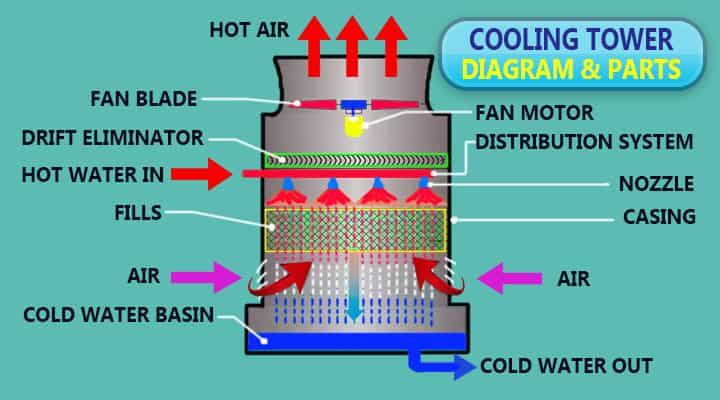
Cooling Tower Parts
The parts of the cooling tower are as follows,
- Fills
- Distribution system
- Drift Eliminators
- Casing
- Distribution valves
- Nozzle
- Collection and distribution basin
- Fans, Motors, Driveshaft, Speed reducers
Description of Cooling Tower Parts
Let’s discuss the basic details of cooling tower parts to get a clear idea,
Fills
The fills may also be called as wet deck or surface. Cooling tower fill is the main heat transfer area available for heat transfer from hot water to cold air.

- There are two types of fills are used one splash fills and the other is film fills.
- In case of splash fills it will disintegrate the hot water from the vertical direction and it will split the water to pass through the next level of splash bars.
- In case of films fills, the thin vertical film of water makes sure the air to contact in with to aid heat transfer. The fills are made of PVC, polypropylene, and wood.
Distribution system
The distribution system of cooling towers depends upon the type of cooling tower and according to the air to water heat flow. The type of cooling towers like cross flow ones uses gravity flow distribution whereas counter flow type uses pressurized water spray systems.
Drift Eliminators
To reduce the drift losses in cooling towers the drift eliminators are used. They are normally kept next to the fills for reducing the drift losses. If you are wondering what is drift loss?

- The drift loss is the loss entrained water through hot air to atmosphere.
- They prevent the escape of water droplets creating sudden changes in the air stream path.
- The drift eliminators are made of PVC.
Casing
As the name suggests the casing provides housing or protection and to transmit the loads to the tower frame. The casing also contains the water within the cooling tower.
Distribution valves
These valves are used to regulate the hot airflow evenly. The outlet of distribution valves is open to the atmosphere. To withstand the corrosive environment the body is made corrosive resistant. Different kinds of valves are used, like
- Isolation valves are sued for regulating the flow from multiple riser towers or isolating a cooling tower cell for standby or maintenance operations.
- Flow control valves like the globe valves are used for equalizing the flow coming from different distribution systems.
- Make up regulator valves are used for automatically adding the water to the cooling water, when some water might get lost due evaporation.
Nozzle
Nozzles are used to provide the uniform distribution of hot water inside a cell of a cooling tower. The plastics are used for nozzles apart from plastics materials like PVC, ABS, polypropylene, glass filled nylon are used.
Collection and distribution basin
The collector basin is available at the bottom of cooling water. So, what this collection basin will do?
- It will collect the falling water that has not yet evaporated or lost due to drift.
- The collection basin also serves as a foundation of cooling tower.
- In case of a distribution basin, it is a small basin with holes or nozzles located above the fill.
Fans, Motors, Driveshaft, Speed reducers
The fans are used in the forced circulation systems. They either force air in or out of the cooling tower.
- The main driver in a cooling tower is the motor, torque from the motor is transferred using driveshaft to the fan or gearbox.
- In some cooling towers, belts and pulleys
 are used instead of gearboxes.
are used instead of gearboxes.
Types of Cooling Towers
Cooling towers are classified based on the following criteria
According to use
- Heating, ventilation & cooling
- Industrial Cooling Towers
According to heat transfer methods
- Closed-circuit
- Wet type
- Dry-type
- Hybrid type
According to build
- Packaged type
- Field erected type
According to airflow generation
- Natural draft
- Mechanical draft
Mechanical draft cooling towers are further classified into three types,
- Forced draft
- Induced draft
- Hybrid draft
According to the Airflow pattern
- Cross flow
- Counter flow
Brief Description of Cooling Towers
According to use
Heating ventilation and cooling
The cooling towers are a major part of the heating ventilation and cooling department. In HVAC system, the cooling tower is used to dispose or reject the unwanted heat received from chiller.
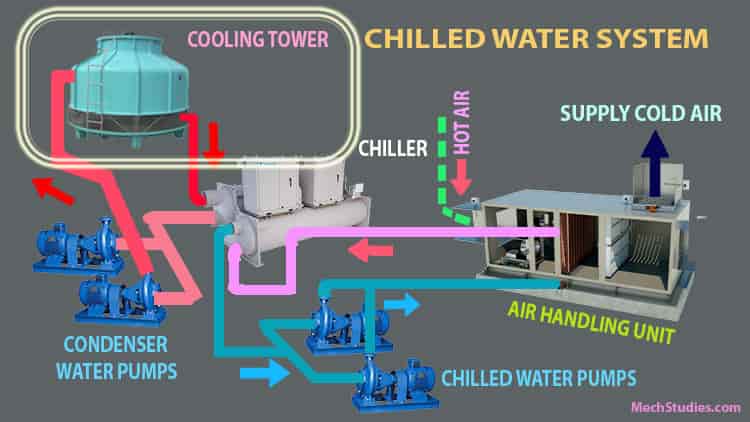
Water cooled chillers are used due to their heat rejection to tower water.
- In hot climate areas, large office buildings, hospitals, and schools the requirement of cooling is more hence the one or more cooling towers are used.
- In HVAC, the cooling towers are paired with water chillers and or water-cooled condensers.
- In HVAC systems the cooling towers have multiple water source heat pumps that have a common piping water loop.
- In this type of system, the condenser rejects heat and that needs to remove from the system. So, a cooling tower is connected to this condenser for heat removal. A separate water circuit included a cooling tower takes the heat from the condenser.
Industrial cooling towers
The industrial cooling towers are used to remove the heat from various sources li,e machineries or heat processed materials.
- If we check the primary use of industrial cooling towers, they are used to remove the heat absorbed in circulating cooling water systems in the power plants, refineries, etc.
- The industrial towers are even bigger in size compared to the HVAC cooling towers.
- The world’s tallest cooling towers are standing in Kalisindh thermal power station Rajasthan India with a height of 2020 meters.
According to Heat Transfer Methods
Closed-circuit towers
In these cooling towers, it passes the working fluid through heat exchangers upon which the clean water is sprayed and a fan induced draft applied. The performance of the closed-circuit cooling tower is near to the wet cooling towers.
Wet cooling towers
The wet cooling towers operates on the principle of evaporative cooling. The main advantage of these wet cooling towers is efficient cooling.
- It is possible to cool the water below ambient temperature.
- It works based on the latent heat & evaporation methods.
- This type of cooling tower consists of “fill” for evaporation.
- Use a large surface area for cooling.
- Size depends on the cooling requirements.
Dry Cooling Towers
If you have known the automobile radiators or air-cooled chillers, the dry cooling towers are kind of the same. It is nothing but an air-cooled heat exchanger.
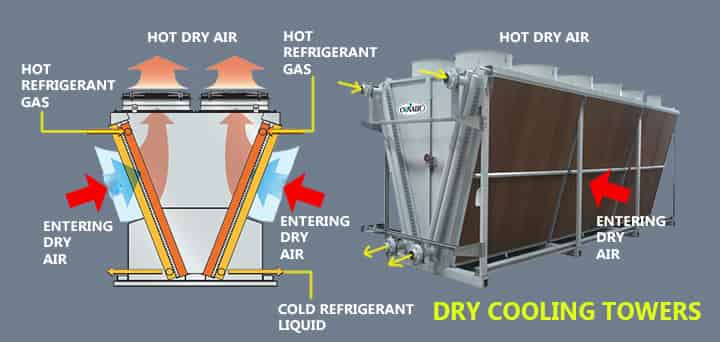
- In case of dry cooling towers, the air will pass through the finned tubes or coils that are exposed to ambient air.
- It works in a closed circuit.
- The heat is removed by sensible heat transfer and no evaporation happens in this type.
- Coils, as well as associated fins, have a high temperature and water (radiator) or refrigerant (air-cooled chillers) is flowing through these coils.
- Air that is a low-temperature medium comes in contact with coils.
- Heat exchange happens between air and waters/refrigerant in coils and coil becomes cool and the air becomes hot and released to the atmosphere.
- Water/refrigerant and air will not have direct contact.
Hybrid Cooling Towers
The hybrid cooling towers as the name suggests can switch between the dry as well as wet operations.
- This characteristic of the hybrid cooling towers is useful for balancing water and energy in various weather conditions.
- Ambient temperature may differ at different times, in this case, hybrid cooling towers are effective.
- More efficient than dry-type cooling towers.
According to Build
Package Type
The package type of cooling towers is mostly factory assembled. They are not huge like industrial cooling towers and can be transported simply on trucks.
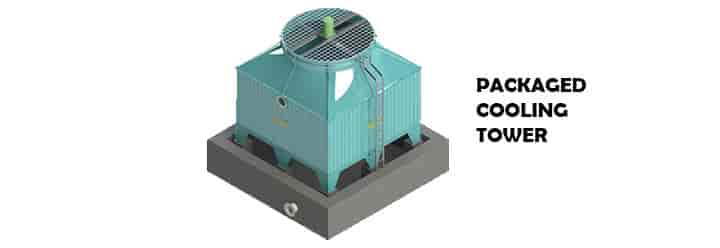
So obviously, the capacity of these package-type cooling towers will be limited. So, because of the capacity they are usually used in the low heat rejection requirements facilities. Like,
- food processing plants,
- textile plants,
- hospitals,
- hotels etc.
Also, they are used in residential areas in some parts.
Field Erected Type
The size of the field erected type cooling towers is more compared to package type cooling towers.
- They have pultruded fiber-reinforced plastic structure, mechanical unit for air draft, and drift eliminator.
- Field erected type cooling towers are generally used in steel processing plants, petroleum refineries, and petrochemical plants.
According to airflow generation
Natural draft
In natural draft cooling towers, it utilizes the buoyancy via a tall chimney.
- The moist and warm ar tends to rise up due to its buoyancy effects as well as density difference.
- These cooling towers don’t use any type of mechanical equipment like fans to create airflow.
- The natural draft towers are not costly, but they can be installed only outdoors. However, for a big capacity natural draft cooling tower, cost as well as time duration, the space requirement is high.
- No fans are used in this kind of cooling tower.
- The climate conditions are considered during the selection.
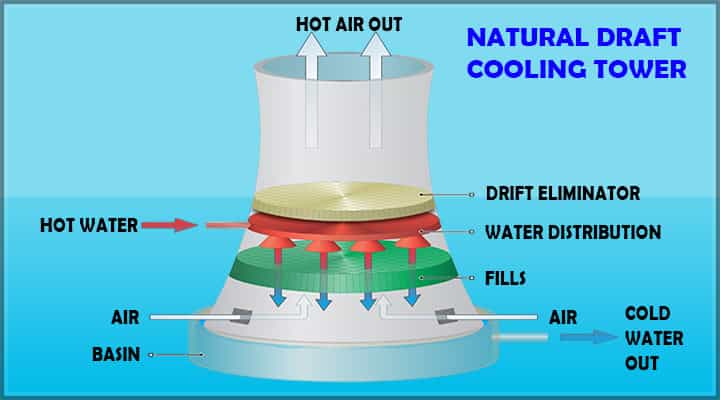
Also, addition to that they have low reliability because the operation is dependant upon the ambient wind and changes in the temperatures.
Mechanical draft
The mechanical draft towers are uses single or multiple fans to generate air flow through the tower. Because of using the fans, the air flow can be maintained according to the requirements. The mechanical draft cooling towers can be classified in two types.
Forced draft
- This type of cooling tower used fans or blowers to blow the air into the cooling tower and the fans are located at the bottom and side of the tower.
- The entrance of airflow has a high velocity because it is pushed by the blower.
- When the air will pass through the tower it will slow down.
- Water falls on the fills to increase the heat transfer area.
- The performance is stable and they can be used in indoor applications where the high static pressure is of concern.
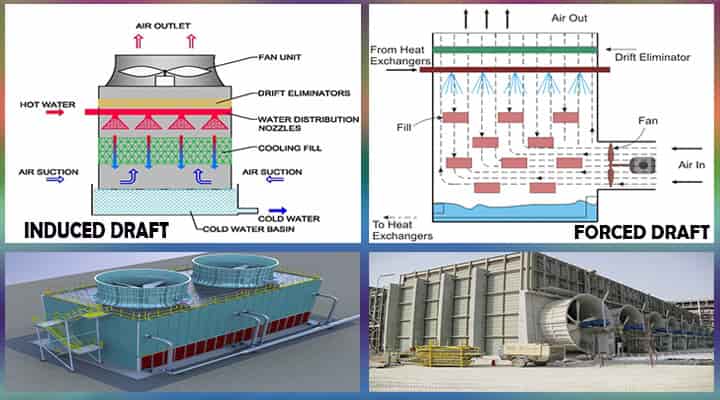
Induced draft
- In induced draft cooling towers the fans are located above or top of the cooling tower.
- They draw or induce the air at the bottom or sides of the tower.
- This arrangement has a low entrance and high exit velocity.
- The induced draft cooling tower is widely used in industrial plants where stable performance is needed.
Hybrid draft
- Hybrid draft type means both dry & wet types are used in a single cooling tower.
- Air passes through the wet section and dry section within a single tower.
- The hybrid draft cooling tower is the same as a natural draft tower. So, they can be called a fan-assisted natural draft cooling tower.
- The fans used in this tower are having low horsepower compared to forced or induced draft cooling towers.
So, these are the types of cooling towers. The working of the cooling tower differs from their types but the working principle is pretty much the same. They work on the principle of evaporative cooling.
According to Airflow Pattern
According to airflow pattern, cooling tower is classified into two types,
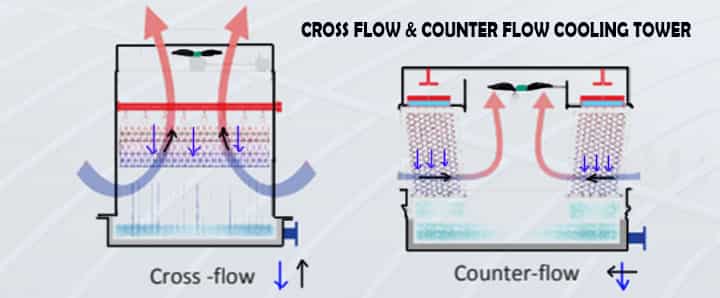
Cross Flow type
- As the name suggests, in this type, water falls vertically and air exchanges heat passing through the fills in the horizontal direction.
- Crossflow happens.
Counter Flow type
- In this counterflow type cooling tower, water falls vertically and air passes through the fills vertically upward direction.
- Counterflow happens.
So, let’s check out the basic working principle of the cooling tower.
How Do Cooling Towers Work?
Cooling Tower Basics
The evaporative cooling is the process in which the warm water from industrial process in pumped up to the top of the cooling tower where the water distribution system is located. Now from the water distribution system, the water will be distributed by cooling tower nozzles to the wet deck. At the same time, the air will be drawn through the air-inlet louvers by fan or buoyancy effects and water comes in contact with air & start to evaporate. So, this evaporation removes the heat.
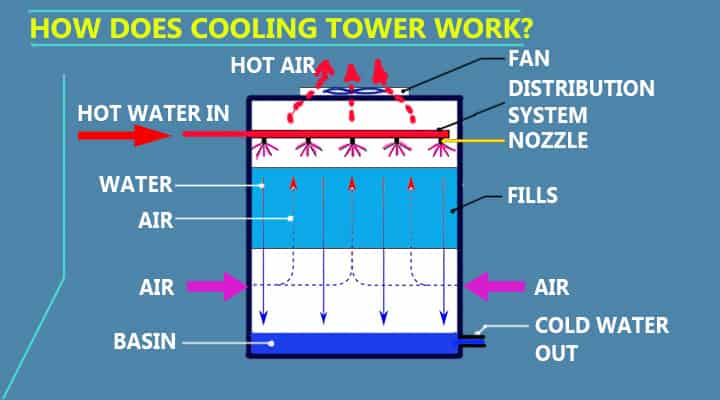
Working Principle
Now in simple words, the working principle are as follows:
Step#1: The warm water coming from the industrial equipment or any heat source will enter the tower it will go to the top in water distribution systems.
Step#2: By taking help from the nozzle the water will be spread evenly at the top. The water is spread so it will obviously flow down the tower.
Step#3: Now the fill equipment spreads it over the large area to increase the water-air contact.
Step#4: We have seen the fans; due to these fans, the large volume of air will be moving constantly.
Step#5: So, the air will become warm and will be made out in the atmosphere.
Design Considerations
During the design of cooling towers, the following things to be taken care,
- Wet-bulb temperature,
- Range
- Approach
- Water flow rate
- Air velocity
- Cooling tower height
Now let’s checkout the applications of the cooling tower.
Heat Balance Basics
Using these flow rates and concentration dimensional units:
- Qm = Make-up water in m3/h
- Qc = Circulating water in m3/h
- Qd = Make-up water in m3/h
- D = Drift Loss of water m3/h
- E = Evaporation Loss of water in m3/h
- Xm = Chloride concentration in make-up water ppm
- Xc = Chloride concentration in circulating water ppm
As per heat balancing of cooling towers, we can write
- Qm =E + Qd + D
As per chloride balancing of cooling towers, we can write
- Qm Xm = Qc XC + DXC = XC (Qm + D)
In simplified equation, to design a cooling tower, the below formula is used for,
Heat rejection, H in kW
H = m x Cp x dT
Where,
- m = Mass flow rate in kg/m3
- v = Volume flow rate in m3/s
- p = Density in Kg/m3
- Cp = Specific heat of water. 4.187 kJ/kg C
H = m x Cp x dT
H = v x p x Cp x dT in kW
Applications of Cooling Tower
Power Generation plants: The cooling tower is widely used in power generation plants. Especially, the steam power plants use the cooling tower even more. In steam power plants when the heat is converted to mechanical energy, all of the heat can’t be converted to mechanical work and here the cooling tower is used.
Heating, ventilation and air conditioning: The cooling towers are used in HVAC systems like in residential or commercial buildings. Heat generated due to people or other equipment’s like computers etc is absorbed by the cooling system and transferred to the cooling tower.
Food industry: The cooling tower is also used in the food and beverage industry. The refrigeration systems need to keep the food and beverage products undercooling.
Industries: The cooling tower is widely used in the factories like sugar factories, Petrochemical industries, oil and gas refineries.
- Diesel engine and gas engine
- Cold storages
- Die-casting machines
Materials of Cooling Towers
There are various materials used to build cooling towers, based on the application as well as project requirements. The main part is cooling tower basin, and selection of material is very critical for this case to avert all kinds of scaling, microbiological problems, etc. These are as follows,
- FRP
- Fiberglass
- Wood
- Cast Iron
- Cast Steel
- Stainless Steel
- Concrete etc.
Plastics are used for louvers, drift eliminators, fan blades, etc.
Maintenance of Cooling Towers
The maintenance of cooling towers is very crucial for the plant operations or the system for which it is used. It is directly proportional to the efficiency of a plant and it is necessary to prevent the common problems like scaling, fouling, corrosion, microbiological etc. The following things need to be kept in mind,
- Always maintain proper water flow as well as airflow.
- There should not be any clogging in the pipes.
- The strainer should be cleaned often which is installed in the main supply line.
- Chemical dosing shall be based on the water quality.
- The frequency of dosing, as well as cleaning, is based on the type of application, location, weather, water quality, etc.
- Fans, it’s blades, motors, belt drive, as applicable shall be checked.
- Water pH level maintains between 8 to 9 to avert corrosion and the same needs to be checked from the conductivity measurement device.
Cooling Tower Advantages
There are so many advantages to use cooling towers in various industries, lets have a look,
- Very low maintenance cost.
- Power consumption is very less, hence, energy saving.
- Nos. of rotating parts are very less.
- Replacement of parts is easy & cheaper.
Disadvantages of Cooling Towers
There are disadvantages as well, as follows,
- The installation cost is high.
- The time of construction is comparatively high.
- In long run, scaling reduces the efficiency of the cooling tower.
- Fouling is another problem with suspended solid particles.
- Corrosion can happen.
- Due to water circulation or spray or moist conditions, bacterial or algae growth may be a constraint.
- Lung disease may happen from contaminated cooling towers.
- Noise problem.
Manufacturers of Cooling Towers
There are many manufacturers available for cooling towers, a few of them are listed below:
- SPX Cooling Technologies
- Evapco
- Pahapur Cooling Tower
- Delta Cooling
- J.E Johnson
- Amertech Tower Services
Standards for Cooling Towers
Let’s see few standards for the design of the cooling tower,
- NFPA 214: Standard on Water-Cooling Towers
- ISO 16345:2014(en), Water-cooling towers — Testing and rating of thermal performance
Conclusion
Hence, we have learned the basics of cooling tower along with the definition, parts, description of all components, etc. Any doubt, please feel free to write to us!
